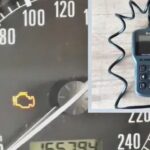Modern vehicles are sophisticated machines, essentially computers on wheels. This complexity means a vast network of electronic components and, consequently, a lot of wiring. To manage this intricate system efficiently and reduce the sheer amount of wires, car manufacturers utilize bus systems. Among these, the Controller Area Network, or CAN-bus, stands out as the backbone of automotive communication. When it comes to diagnosing issues within these complex systems, the OBD II scan tool becomes indispensable, often working hand-in-hand with the CAN-bus.
What is a Bus System in Automotive Electronics?
Imagine needing a separate wire for every signal in your car – from headlights to sensors. This would lead to an incredibly complex and heavy wiring harness, increasing costs and vehicle weight. A bus system offers a smarter solution: transmitting multiple signals through fewer wires. Think of it as a highway for electronic data within your car, allowing different components to communicate effectively using a shared pathway.
To illustrate, consider controlling four lamps in a vehicle. Without a bus system, you’d need a dedicated wire for each lamp. For example:
- Lamp 1: Wire 1 controls Lamp 1 (On/Off)
- Lamp 2: Wire 2 controls Lamp 2 (On/Off)
- Lamp 3: Wire 3 controls Lamp 3 (On/Off)
- Lamp 4: Wire 4 controls Lamp 4 (On/Off)
This simple system quickly becomes cumbersome as the number of controlled components increases.
Alt text: Diagram illustrating a simple car wiring system with multiple wires connecting components.
However, with a bus system, we can significantly reduce wiring. A basic example might look like this:
- Lamp 1: Signal 1 on Wire 1 (Selector), Signal on Wire 2 (On/Off)
- Lamp 2: Signal 2 on Wire 1 (Selector), Signal on Wire 2 (On/Off)
- Lamp 3: Signal 3 on Wire 1 (Selector), Signal on Wire 2 (On/Off)
- Lamp 4: Signal 4 on Wire 1 (Selector), Signal on Wire 2 (On/Off)
In this simplified bus system, just two wires can manage multiple lamps. One wire acts as a selector, identifying which lamp to control, while the other wire dictates the action (on or off). This principle extends to the complex electronic network within your car.
CAN-Bus: The Language of Your Car
The Controller Area Network (CAN-bus) is the predominant bus system in modern vehicles. It’s engineered to reliably transmit large amounts of data between various electronic control units (ECUs) within a car using only two wires. These ECUs manage everything from the engine and transmission to braking systems and infotainment. CAN-bus allows them to communicate and coordinate actions seamlessly. For a deeper dive into the technical aspects, resources like the Wikipedia page on CAN bus provide comprehensive information.
OBD-II: Diagnosing Your Vehicle’s Health
Now, where does the On-Board Diagnostics II (OBD-II) system fit in? OBD-II is a high-level protocol designed specifically for vehicle diagnostics. Think of OBD-II as a standardized language that diagnostic tools use to communicate with your car’s computer. It’s not a bus system itself, but rather a protocol that often utilizes bus systems like CAN to transmit diagnostic data.
Imagine OBD-II as English, the language you speak to understand your car, and CAN-bus as the telephone line that carries your conversation. The OBD-II protocol dictates the format and content of the diagnostic messages, while the CAN-bus provides the physical pathway for this communication to occur.
Alt text: Image showing a typical OBD II port location under the dashboard of a vehicle.
OBD-II is considered a standard, but it encompasses various sub-standards, protocols, and bus systems. This standardization is crucial as it allows a single OBD II scan tool to be compatible with a wide range of vehicles for diagnostic purposes.
Utilizing an OBD II Scan Tool with CAN-Bus
Using an OBD II scan tool on a CAN-bus equipped vehicle is straightforward. The OBD-II port, standardized across most modern cars, is the gateway to your vehicle’s diagnostic data. To use a scan tool, simply locate the OBD-II port – typically found within easy reach of the driver, often under the dashboard or in the center console – and plug in your scanner.
Since CAN-bus is a primary transport protocol within the OBD-II specification, most OBD II scan tools are inherently designed to communicate over CAN. The scan tool will then interpret the data transmitted via the CAN-bus, providing you with valuable insights into your vehicle’s health and potentially pinpointing any issues.
In essence, understanding the relationship between OBD II scan tools and CAN-bus scanners is crucial for anyone involved in modern vehicle diagnostics. The CAN-bus provides the communication network, while the OBD-II protocol and scan tools allow us to tap into this network for diagnostics and maintenance.

